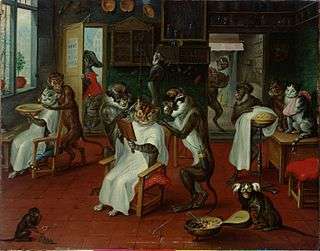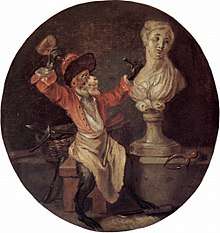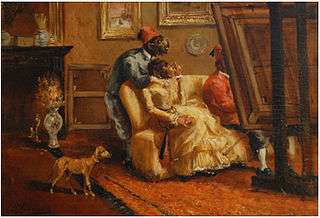Singerie
Singerie is the name given to a visual arts genre depicting monkeys imitating human behavior, often fashionably attired, intended as a diverting sight, always with a gentle cast of mild satire. The term is derived from the French word for "Monkey Trick".

Though it has a long history, the height of the genre was in the 18th century, in the Rococo.
History
The practise can be traced as far back as Ancient Egypt; Cyril Aldred detected a love of singerie that he found characteristic of the late Eighteenth Dynasty of Egypt;[1] Throughout the medieval period in Europe, monkeys were seen "as a symbol of downgraded humanity",[2] and were used to mimic man and his foibles, often appearing in the margins of illuminated manuscripts.[3][4]

Comical scenes with monkeys appearing in human attire and a human environment originated as a pictorial genre in Flemish painting in the 16th century and were further developed in the 17th century. The Flemish engraver Pieter van der Borcht introduced the singerie as an independent theme around 1575 in a series of prints, which are strongly embedded in the artistic tradition of Pieter Bruegel the Elder, whose 1562 Two Monkeys probably started the craze. These prints were widely disseminated and the theme was then picked up by other Flemish artists, in particular by those in Antwerp such as Frans Francken the Younger, Jan Brueghel the Elder and the Younger, Sebastiaen Vrancx and Jan van Kessel the Elder. David Teniers the Younger became the principal practitioner of the genre and developed it further with his younger brother Abraham Teniers. The two brothers were able to cater to the prevailing taste in the art market and were thus instrumental in spreading the genre outside Flanders. Later in the 17th century artists like Nicolaes van Verendael, principally known as a painter of flower still lifes started to paint ‘monkey scenes’ as well.[5]
Singeries became popular among French artists in the early 18th century. French decorator and designer Jean Berain the Elder included dressed figures of monkeys in many wall decorations, the great royal ébéniste André Charles Boulle used them in his work[6] and Watteau painted The Monkey Sculptor, a critique of art and artists' habit of "aping" nature.[7]

A complete monkey orchestra, the "Monkey Band" (Affenkapelle, "ape orchestra" in German) was produced in Meissen porcelain, and copied by Chelsea porcelain and other factories. In France the most famous such rococo decor are Christophe Huet's Grande Singerie and Petite Singerie decors at the Château de Chantilly, the basis for the Meissen figures. In England the French painter Andieu de Clermont is also known for his singeries: the most famous decorates the ceiling of the Monkey Room at Monkey Island Hotel, located on Monkey Island in Bray-on-Thames, England. The Grade I listed buildings, which have housed guests since 1840 were built in the 1740s by Charles Spencer, 3rd Duke of Marlborough.
Singeries regained popularity in the 19th century and artists then successful in this genre included Zacharie Noterman, Emmanuel Noterman, Charles Verlat, Sir Edwin Henry Landseer, Edmund Bristow, Alexandre-Gabriel Decamps, Charles Monginot and Paul Friedrich Meyerheim.[8]
Notes
- Cyril Alfred, 1955. New Kingdom Art in Ancient Egypt
- Jean H. Duffy (2003). Signs and Designs: Art and Architecture in the Work of Michel Butor. Liverpool University Press. pp. 267–. ISBN 978-0-85323-788-4.
- Nicole Garnier-Pelle; Anne Forray-Carlier; Marie-Christine Anselm (2011). The Monkeys of Christophe Huet: Singeries in French Decorative Arts. J. Paul Getty Museum. ISBN 978-1-60606-065-0.
- Charles Taylor (1807). The Literary Panorama. p. 427.
The prayer book written for Charles V. of Austria by his mistress, had, on every page, monkeys mimicking religious ceremonies, in the most incongruous manner
- Bert Schepers, Monkey Madness in Seventeenth-Century Antwerp, in: The Rubenianum Quarterly, 2012 2, p. 5
- R.H. Randall Jr, "Templates for Boulle Singerie" The Burlington Magazine 111 No. 798 (September 1969), pp. 549-553.
- Lucia Impelluso (2004). Nature and Its Symbols. Getty Publications. pp. 201–. ISBN 978-0-89236-772-6.
- Zacharias Noterman, Les Plaideurs ('The Litigants') at Art of the Print
External links
| Wikimedia Commons has media related to Singeries. |
- "The Singerie: Monkeys acting as Humans in Art" Public Domain Review article with many images
- Depictions of monkeys in medieval manuscripts Pinterest